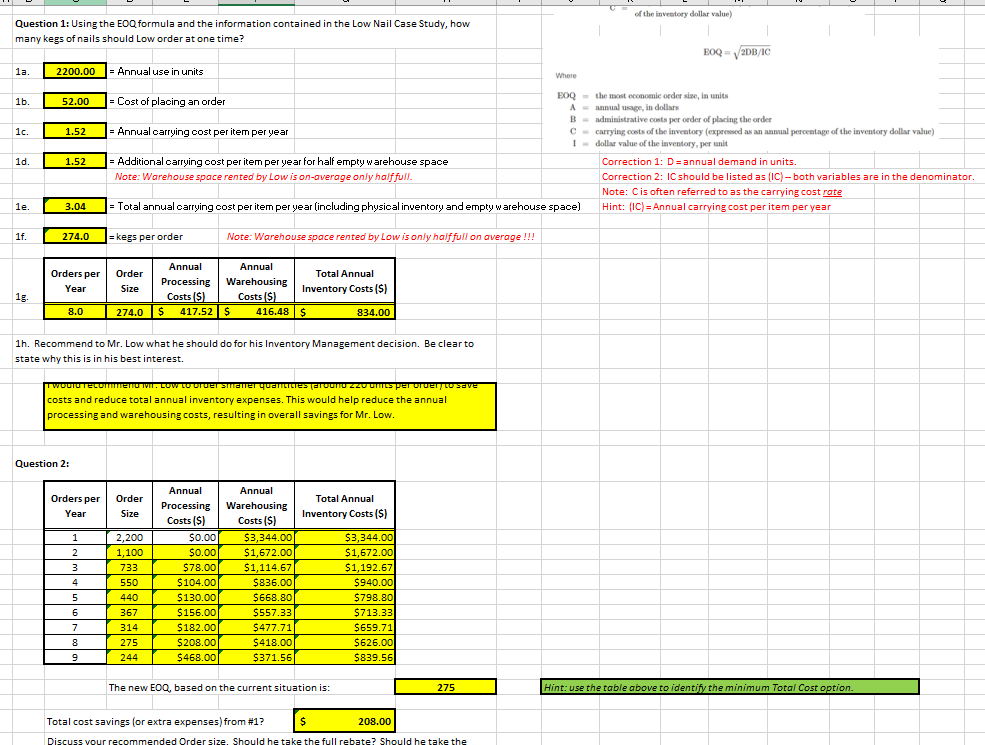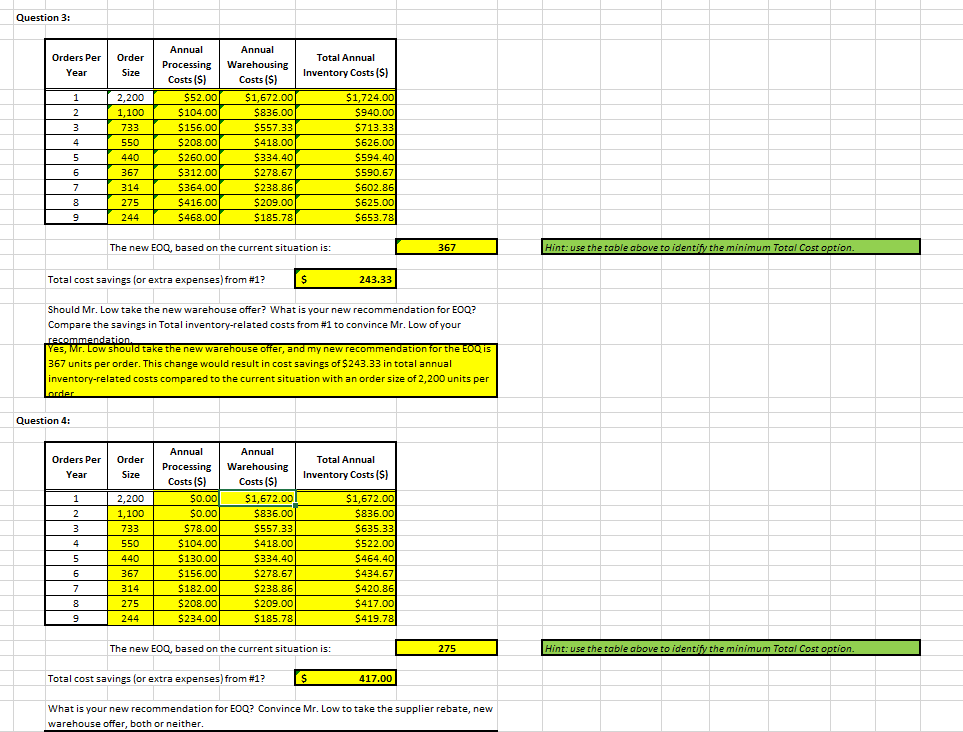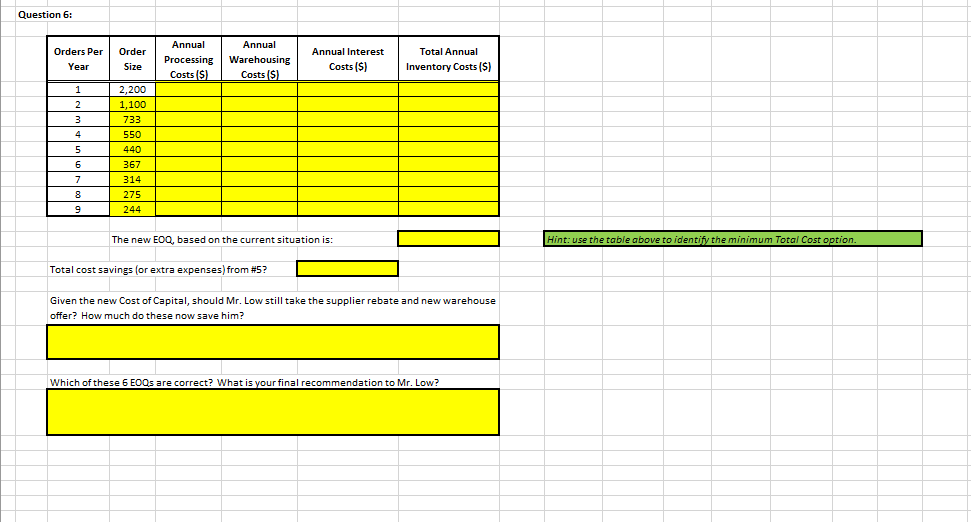Question
please answer and fill out each highlighted yellow cell with formula so I can see for question 4 and 5 only: (Also please answer the
please answer and fill out each highlighted yellow cell with formula so I can see for question 4 and 5 only: (Also please answer the questions in the yellow boxes on 4 and 5 only)
Case - Low Nail Company After making some wise short-term investments at a race track, Chris Low had some additional cash to invest in a business. The most promising opportunity at the time was in building supplies, so Low bought a business that specialized in sales of one size of nail. The annual volume of nails was 2,200 kegs, and they were sold to retail customers in an even flow. Low was uncertain how many nails to order at any time. Initially, only two costs concerned him: order-processing costs, which were $52 per order without regard to size, and warehousing costs, which were $1.52 per year per keg space. This meant that Low had to rent a constant amount of warehouse space for the year, and it had to be large enough to accommodate an entire order when it arrived. Low was not worried about maintaining safety stocks, mainly because the outward flow of goods was so even. Low bought his nails on a delivered basis.
1. Using the EOQ methods outlined in the chapter, how many kegs of nails should Low order at one time? Compute the corresponding Orders per year, Annual processing cost, Annual warehousing cost, and the Total inventory-related cost.
2. Assume all conditions in Question 1 hold, except that Lows supplier now offers a quantity discount in the form of absorbing all or part of Lows order-processing costs. For orders of 750 or more kegs of nails, the supplier will absorb all the order-processing costs; for orders between 250 and 749 kegs, the supplier will absorb half. Use the provided cost table to estimate Lows new EOQ. Should he take the full rebate? Should he take the partial rebate? Should he avoid the rebate? Compare the savings in Total inventory-related costs from #1 to convince Mr. Low of your recommendation.
3. Temporarily, ignore your work on Question 2. Assume that Lows warehouse offers to rent Low space on the basis of the average number of kegs Low will have in stock, rather than on the maximum number of kegs Low would need room for whenever a new shipment arrived. The storage charge per keg remains the same. Does this change the answer to Question 1? If so, what is the new answer? Should Mr. Low take the new warehouse offer? What is your new recommendation for EOQ? Compare the savings in Total inventory-related costs from #1 to convince Mr. Low of your recommendation.
4. Take into account the answer to Question 1 and the suppliers new policy outlined in Question 2 and the warehouses new policy in Question 3. What is your new recommendation for EOQ? Convince Mr. Low to take the supplier rebate, new warehouse offer, both or neither.
5. Temporarily, ignore your work on Questions 2, 3, and 4. Lows luck at the race track is over; he now must borrow money to finance his inventory of nails. Looking at the situation outlined in Question 1, assume that the wholesale cost of nails is $42 per keg and that Low must pay interest at the rate of 1.3% per month on unsold inventory. What is his new EOQ and how has his Total inventory costs changed? Discuss how this situation is different from when you used company cash-on-hand to purchase inventory in the past.
6. Taking into account all the factors listed in Questions 1, 2, 3, and 5, calculate Lows EOQ for kegs of nails. Given the new Cost of Capital, should Mr. Low still take the supplier rebate and new warehouse offer? How much do these now save him? Which of these 6 EOQs are correct? What is your final recommendation to Mr. Low?



 Question 1: Using the EOQ formula and the information contained in the Low Nail Case Study, how many kegs of nails should Low order at one time? 1a. 2200.00 16. 52.00 = Cost of placing an order 1c. 1.52 = Annual carrying cost per item per year 1d. 1.52 = Additional carrying cost per item per year for half empty warehouse space Note: Warehouse space rented by Low is on-average only halffull. EOQ=2DB/IC Where EOQ = the most econoenic order sise, in units A= annual usage, in dollars B = admiaistrative costs per oeder of placing the arder C = carrying costs of the inveatory (expeesed as an annual peroeatage of the iaventary dollar value) 1 = dollar value of the iaventory, per unit 1e. 3.04 = Total annual carrying cost per item per year (inoluding physical inventory and empty warehouse space) Correction 1: D= annual demand in units. Correction 2: IC should be listed as (IC) - both variables are in the denominator. Note: C is often referred to as the carrying cost rate Hint: (IC)= Annual carrying cost per item per year 16. 274.0 = kegs per order Note: Warehouse space rented by Low is only half full on average !!! 1g. 1h. Recommend to Mr. Low what he should do for his Inventory Management decision. Be clear to state why this is in his best interest. costs and reduce total annual inventory expenses. This would help reduce the annual processing and warehousing costs, resulting in overall savings for Mr. Low. Question 2: \begin{tabular}{|c|c|r|c|r|} \hline OrdersperYear & OrderSize & AnnualProcessingCosts($) & AnnualWarehousingCosts[$) & TotalAnnualInventoryCosts($) \\ \hline \hline 1 & 2,200 & $0.00 & $3,344.00 & $3,344.00 \\ \hline 2 & 1,100 & $0.00 & $1,672.00 & $1,672.00 \\ \hline 3 & 733 & $78.00 & $1,114.67 & $1,192.67 \\ \hline 4 & 550 & $104.00 & $836.00 & $940.00 \\ \hline 5 & 440 & $130.00 & $668.80 & $798.80 \\ \hline 6 & 367 & $156.00 & $557.33 & $713.33 \\ \hline 7 & 314 & $182.00 & $477.71 & $659.71 \\ \hline 8 & 275 & $208.00 & $418.00 & $626.00 \\ \hline 9 & 244 & $468.00 & $371.56 & $839.56 \\ \hline \end{tabular} The new EOQ, based on the current situation is: 275 Hint: use the table above to identify the minimum Total Cost option. Total cost savings (or extra expenses) from \#1? $208.00 Question 3: \begin{tabular}{|c|c|r|r|r|} \hline OrdersPerYear & OrderSize & AnnualProcessingCosts($) & AnnualWarehousingCosts[$) & TotalAnnualInventoryCosts($) \\ \hline \hline 1 & 2,200 & $52.00 & $1,672.00 & $1,724.00 \\ \hline 2 & 1,100 & $104.00 & $836.00 & $940.00 \\ \hline 3 & 733 & $156.00 & $557.33 & $713.33 \\ \hline 4 & 550 & $208.00 & $418.00 & $626.00 \\ \hline 5 & 440 & $260.00 & $334.40 & $594.40 \\ \hline 6 & 367 & $312.00 & $278.67 & $590.67 \\ \hline 7 & 314 & $364.00 & $238.86 & $602.86 \\ \hline 8 & 275 & $416.00 & $209.00 & $625.00 \\ \hline 9 & 244 & $468.00 & $185.78 & $653.78 \\ \hline & & & & \end{tabular} The new EOQ, based on the current situation is: 367 Should Mr. Low take the new warehouse offer? What is your new recommendation for EOQ? Compare the savings in Total inventory-related costs from \#1 to convince Mr. Low of your recommendation. Yes, Mr. Low should take the new warehouse offer, and my new recommendation for the EOQTis 367 units per order. This change would result in cost savings of $243.33 in total annual inventory-related costs compared to the current situation with an order size of 2,200 units per arder Question 4: \begin{tabular}{|c|c|r|r|r|} \hline OrdersPerYear & OrderSize & AnnualProcessingCosts($) & AnnualWarehousingCosts($) & TotalAnnualInventoryCosts($) \\ \hline \hline 1 & 2,200 & $0.00 & $1,672.00 & $1,672.00 \\ \hline 2 & 1,100 & $0.00 & $836.00 & $836.00 \\ \hline 3 & 733 & $78.00 & $557.33 & $635.33 \\ \hline 4 & 550 & $104.00 & $418.00 & $522.00 \\ \hline 5 & 440 & $130.00 & $334.40 & $464.40 \\ \hline 6 & 367 & $156.00 & $278.67 & $434.67 \\ \hline 7 & 314 & $182.00 & $238.86 & $420.86 \\ \hline 8 & 275 & $208.00 & $209.00 & $417.00 \\ \hline 9 & 244 & $234.00 & $185.78 & $419.78 \\ \hline \end{tabular} The new EOQ, based on the current situation is: 275 Total cost savings (or extra expenses) from \#1? $417.00 What is your new recommendation for EOQ? Convince Mr. Low to take the supplier rebate, new warehouse offer, both or neither. Hint: use the table above to identify the minimum Total Cost option. Hint: use the table above to identify the minimum Total Cost option. Hint: use the table above to identify the minimum Total Cost option. Question 5: The new EOQ, based on the current situation is: Total cost savings (or extra expenses) from \#1? What is his new EOQ and how has his Total inventory costs changed? Discuss how this situation is different from when you used company cash-on-hand to purchase inventory in the past. Question 6: The new EOQ, based on the current situation is: Total cost savings (or extra expenses) from \#5? New Data Provided: InterestRate=1.30%monthly=15.6%annually Valueofitems(1)=$42.00each Hint: use the table above to identify the minimum Total Cost option. Hint: use the table above to identify the minimum Total Cost option. Hint: use the table above to identify the minimum Total Cost option. Question 6: The new EOQ, based on the current situation is: Hint: use the table above to identify the minimum Total Cost option. Total cost savings (or extra expenses) from #5 ? Given the new Cost of Capital, should Mr. Low still take the supplier rebate and new warehouse offer? How much do these now save him? Which of these 6EOQ s are correct? What is your final recommendation to Mr. Low
Question 1: Using the EOQ formula and the information contained in the Low Nail Case Study, how many kegs of nails should Low order at one time? 1a. 2200.00 16. 52.00 = Cost of placing an order 1c. 1.52 = Annual carrying cost per item per year 1d. 1.52 = Additional carrying cost per item per year for half empty warehouse space Note: Warehouse space rented by Low is on-average only halffull. EOQ=2DB/IC Where EOQ = the most econoenic order sise, in units A= annual usage, in dollars B = admiaistrative costs per oeder of placing the arder C = carrying costs of the inveatory (expeesed as an annual peroeatage of the iaventary dollar value) 1 = dollar value of the iaventory, per unit 1e. 3.04 = Total annual carrying cost per item per year (inoluding physical inventory and empty warehouse space) Correction 1: D= annual demand in units. Correction 2: IC should be listed as (IC) - both variables are in the denominator. Note: C is often referred to as the carrying cost rate Hint: (IC)= Annual carrying cost per item per year 16. 274.0 = kegs per order Note: Warehouse space rented by Low is only half full on average !!! 1g. 1h. Recommend to Mr. Low what he should do for his Inventory Management decision. Be clear to state why this is in his best interest. costs and reduce total annual inventory expenses. This would help reduce the annual processing and warehousing costs, resulting in overall savings for Mr. Low. Question 2: \begin{tabular}{|c|c|r|c|r|} \hline OrdersperYear & OrderSize & AnnualProcessingCosts($) & AnnualWarehousingCosts[$) & TotalAnnualInventoryCosts($) \\ \hline \hline 1 & 2,200 & $0.00 & $3,344.00 & $3,344.00 \\ \hline 2 & 1,100 & $0.00 & $1,672.00 & $1,672.00 \\ \hline 3 & 733 & $78.00 & $1,114.67 & $1,192.67 \\ \hline 4 & 550 & $104.00 & $836.00 & $940.00 \\ \hline 5 & 440 & $130.00 & $668.80 & $798.80 \\ \hline 6 & 367 & $156.00 & $557.33 & $713.33 \\ \hline 7 & 314 & $182.00 & $477.71 & $659.71 \\ \hline 8 & 275 & $208.00 & $418.00 & $626.00 \\ \hline 9 & 244 & $468.00 & $371.56 & $839.56 \\ \hline \end{tabular} The new EOQ, based on the current situation is: 275 Hint: use the table above to identify the minimum Total Cost option. Total cost savings (or extra expenses) from \#1? $208.00 Question 3: \begin{tabular}{|c|c|r|r|r|} \hline OrdersPerYear & OrderSize & AnnualProcessingCosts($) & AnnualWarehousingCosts[$) & TotalAnnualInventoryCosts($) \\ \hline \hline 1 & 2,200 & $52.00 & $1,672.00 & $1,724.00 \\ \hline 2 & 1,100 & $104.00 & $836.00 & $940.00 \\ \hline 3 & 733 & $156.00 & $557.33 & $713.33 \\ \hline 4 & 550 & $208.00 & $418.00 & $626.00 \\ \hline 5 & 440 & $260.00 & $334.40 & $594.40 \\ \hline 6 & 367 & $312.00 & $278.67 & $590.67 \\ \hline 7 & 314 & $364.00 & $238.86 & $602.86 \\ \hline 8 & 275 & $416.00 & $209.00 & $625.00 \\ \hline 9 & 244 & $468.00 & $185.78 & $653.78 \\ \hline & & & & \end{tabular} The new EOQ, based on the current situation is: 367 Should Mr. Low take the new warehouse offer? What is your new recommendation for EOQ? Compare the savings in Total inventory-related costs from \#1 to convince Mr. Low of your recommendation. Yes, Mr. Low should take the new warehouse offer, and my new recommendation for the EOQTis 367 units per order. This change would result in cost savings of $243.33 in total annual inventory-related costs compared to the current situation with an order size of 2,200 units per arder Question 4: \begin{tabular}{|c|c|r|r|r|} \hline OrdersPerYear & OrderSize & AnnualProcessingCosts($) & AnnualWarehousingCosts($) & TotalAnnualInventoryCosts($) \\ \hline \hline 1 & 2,200 & $0.00 & $1,672.00 & $1,672.00 \\ \hline 2 & 1,100 & $0.00 & $836.00 & $836.00 \\ \hline 3 & 733 & $78.00 & $557.33 & $635.33 \\ \hline 4 & 550 & $104.00 & $418.00 & $522.00 \\ \hline 5 & 440 & $130.00 & $334.40 & $464.40 \\ \hline 6 & 367 & $156.00 & $278.67 & $434.67 \\ \hline 7 & 314 & $182.00 & $238.86 & $420.86 \\ \hline 8 & 275 & $208.00 & $209.00 & $417.00 \\ \hline 9 & 244 & $234.00 & $185.78 & $419.78 \\ \hline \end{tabular} The new EOQ, based on the current situation is: 275 Total cost savings (or extra expenses) from \#1? $417.00 What is your new recommendation for EOQ? Convince Mr. Low to take the supplier rebate, new warehouse offer, both or neither. Hint: use the table above to identify the minimum Total Cost option. Hint: use the table above to identify the minimum Total Cost option. Hint: use the table above to identify the minimum Total Cost option. Question 5: The new EOQ, based on the current situation is: Total cost savings (or extra expenses) from \#1? What is his new EOQ and how has his Total inventory costs changed? Discuss how this situation is different from when you used company cash-on-hand to purchase inventory in the past. Question 6: The new EOQ, based on the current situation is: Total cost savings (or extra expenses) from \#5? New Data Provided: InterestRate=1.30%monthly=15.6%annually Valueofitems(1)=$42.00each Hint: use the table above to identify the minimum Total Cost option. Hint: use the table above to identify the minimum Total Cost option. Hint: use the table above to identify the minimum Total Cost option. Question 6: The new EOQ, based on the current situation is: Hint: use the table above to identify the minimum Total Cost option. Total cost savings (or extra expenses) from #5 ? Given the new Cost of Capital, should Mr. Low still take the supplier rebate and new warehouse offer? How much do these now save him? Which of these 6EOQ s are correct? What is your final recommendation to Mr. Low Step by Step Solution
There are 3 Steps involved in it
Step: 1

Get Instant Access to Expert-Tailored Solutions
See step-by-step solutions with expert insights and AI powered tools for academic success
Step: 2

Step: 3

Ace Your Homework with AI
Get the answers you need in no time with our AI-driven, step-by-step assistance
Get Started


